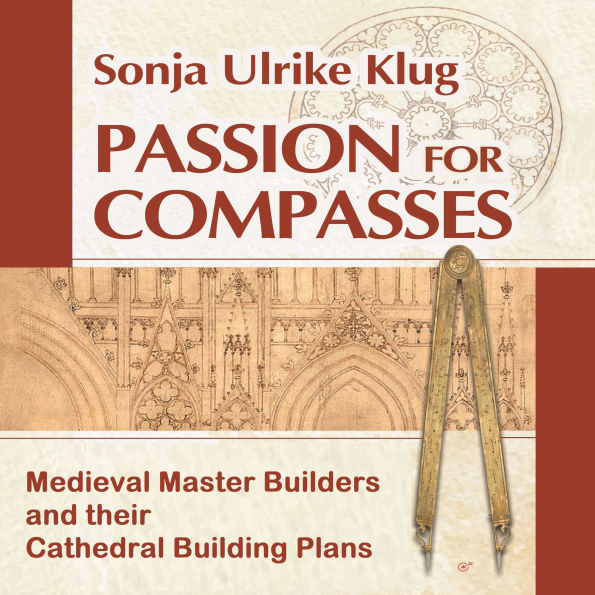The architectural history of the Middle Ages is full of surprises
It is hard to imagine today that relatively few construction plans have been found for the impressive churches and cathedrals of the Romanesque and Gothic periods. Where did most of the drawings go? Were the plans destroyed in Europe or lost over time? Or were they never made at all?
Although there are very few architectural drawings, there were numerous compasses. What were they used for and how? Was it possible to design complex buildings such as churches and cathedrals without blueprints?
The author takes her readers on an exciting cultural and historical journey through time
She looks at the spread of papyrus, parchment and paper and traces the ability to write and calculate in Europe. She also looks at the construction process in historical illustrations and draws comparisons with Arabic architecture. Finally, the author presents the various types of compasses that were available and explains how the drawing skills of master builders developed up to the Renaissance.
These insights into the history of architecture lead to some surprising discoveries: Architects of the Middle Ages thought and planned very differently from how we think today.
Dr. Sonja Ulrike Klug has been studying medieval architecture for over 20 years. She has published several books on Gothic cathedrals.
1145587624
It is hard to imagine today that relatively few construction plans have been found for the impressive churches and cathedrals of the Romanesque and Gothic periods. Where did most of the drawings go? Were the plans destroyed in Europe or lost over time? Or were they never made at all?
Although there are very few architectural drawings, there were numerous compasses. What were they used for and how? Was it possible to design complex buildings such as churches and cathedrals without blueprints?
The author takes her readers on an exciting cultural and historical journey through time
She looks at the spread of papyrus, parchment and paper and traces the ability to write and calculate in Europe. She also looks at the construction process in historical illustrations and draws comparisons with Arabic architecture. Finally, the author presents the various types of compasses that were available and explains how the drawing skills of master builders developed up to the Renaissance.
These insights into the history of architecture lead to some surprising discoveries: Architects of the Middle Ages thought and planned very differently from how we think today.
Dr. Sonja Ulrike Klug has been studying medieval architecture for over 20 years. She has published several books on Gothic cathedrals.
Passion for Compasses: Medieval Master Builders and their Cathedral Building Plans
The architectural history of the Middle Ages is full of surprises
It is hard to imagine today that relatively few construction plans have been found for the impressive churches and cathedrals of the Romanesque and Gothic periods. Where did most of the drawings go? Were the plans destroyed in Europe or lost over time? Or were they never made at all?
Although there are very few architectural drawings, there were numerous compasses. What were they used for and how? Was it possible to design complex buildings such as churches and cathedrals without blueprints?
The author takes her readers on an exciting cultural and historical journey through time
She looks at the spread of papyrus, parchment and paper and traces the ability to write and calculate in Europe. She also looks at the construction process in historical illustrations and draws comparisons with Arabic architecture. Finally, the author presents the various types of compasses that were available and explains how the drawing skills of master builders developed up to the Renaissance.
These insights into the history of architecture lead to some surprising discoveries: Architects of the Middle Ages thought and planned very differently from how we think today.
Dr. Sonja Ulrike Klug has been studying medieval architecture for over 20 years. She has published several books on Gothic cathedrals.
It is hard to imagine today that relatively few construction plans have been found for the impressive churches and cathedrals of the Romanesque and Gothic periods. Where did most of the drawings go? Were the plans destroyed in Europe or lost over time? Or were they never made at all?
Although there are very few architectural drawings, there were numerous compasses. What were they used for and how? Was it possible to design complex buildings such as churches and cathedrals without blueprints?
The author takes her readers on an exciting cultural and historical journey through time
She looks at the spread of papyrus, parchment and paper and traces the ability to write and calculate in Europe. She also looks at the construction process in historical illustrations and draws comparisons with Arabic architecture. Finally, the author presents the various types of compasses that were available and explains how the drawing skills of master builders developed up to the Renaissance.
These insights into the history of architecture lead to some surprising discoveries: Architects of the Middle Ages thought and planned very differently from how we think today.
Dr. Sonja Ulrike Klug has been studying medieval architecture for over 20 years. She has published several books on Gothic cathedrals.
22.68
In Stock
5
1

Passion for Compasses: Medieval Master Builders and their Cathedral Building Plans

Passion for Compasses: Medieval Master Builders and their Cathedral Building Plans
FREE
with a B&N Audiobooks Subscription
Or Pay
$22.68
22.68
In Stock

Product Details
| BN ID: | 2940190902426 |
|---|---|
| Publisher: | Kluges Verlag |
| Publication date: | 08/06/2024 |
| Edition description: | Unabridged |
| Age Range: | 12 - 17 Years |
Videos

From the B&N Reads Blog
